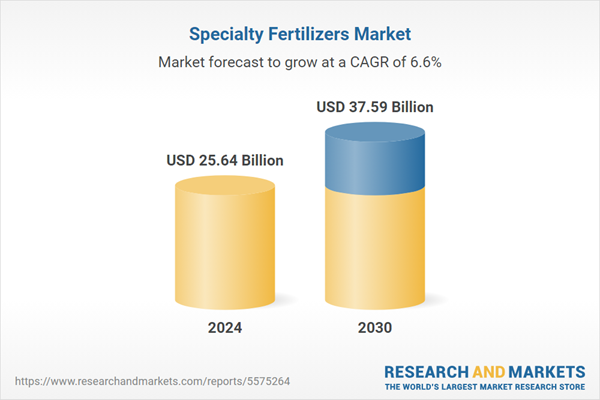Free Webex Call
Global Specialty Fertilizers Market was valued at USD 25.64 Billion in 2024 and is expected to reach USD 37.59 Billion by 2030 with a CAGR of 6.58% during the forecast period. Specialty fertilizers play a crucial role in optimizing crop growth and development. By effectively releasing fertilizer nutrients and regulating moisture levels, these fertilizers contribute to the proper growth of various crops. They are specifically formulated to meet the unique requirements of different plant and soil conditions, enhancing plant activity and productivity. Speak directly to the analyst to clarify any post sales queries you may have.
10% Free customizationThis report comes with 10% free customization, enabling you to add data that meets your specific business needs.
Additionally, specialty fertilizers help reduce the adverse effects of excessive ionic concentration and minimize nutrient loss, resulting in improved nutrient uptake. These fertilizers find applications in non-farm settings such as cemeteries, parks, golf courses, and residential landscapes, as well as for research purposes. They are available in different forms and contain essential primary, secondary, and micronutrients. By promoting nutrient absorption and reducing environmental nutrient losses, specialty fertilizers contribute to sustainable agriculture practices.
Key Market Drivers
Rising Demand for High Efficiency Fertilizers
The rising global demand for high-efficiency fertilizers is projected to significantly fuel the growth of the specialty fertilizers market. Specialty fertilizers, known for their controlled-release properties, provide nutrients to crops efficiently and reduce potential losses to the environment. This increased efficiency is critical in an era where sustainability and resource optimization are key. With a growing global population, the pressure on agriculture to meet food demands is ever-increasing. Thus, high-efficiency fertilizers are no longer a choice, but a necessity.The implementation of specialty fertilizers can enhance agricultural productivity by ensuring nutrients are delivered effectively to crops, fostering healthier growth and higher yields. Additionally, these fertilizers prove to be cost-effective in the long run, reducing the frequency of application compared to conventional fertilizers, which further justifies their rising popularity. Climate change and environmental concerns also play a crucial role, as the need to reduce nutrient runoff into the water bodies is of paramount importance. Specialty fertilizers, as a result, come to the forefront as the environmentally conscious choice. Therefore, the escalating demand for high-efficiency fertilizers, driven by the need for greater agricultural productivity, cost-effectiveness, and environmental sustainability, is expected to propel the global specialty fertilizers market in the foreseeable future.
Key Market Challenges
High Cost of Fertilizers
The global demand for specialty fertilizers may be significantly affected by the surging costs of these products. These fertilizers, while containing essential nutrients for crops' robust growth, come at a high price due to the specialized manufacturing processes and unique ingredients employed. The increasing cost of production, in turn, leads to higher market prices for these specialty products. Many farmers, particularly those in developing nations, struggle to afford these higher costs which can restrict access to these beneficial agricultural inputs. Consequently, the high cost of specialty fertilizers is expected to decrease its demand globally as farmers seek cost-effective alternatives.This search for affordability may push farmers to return to conventional fertilizers or experiment with organic farming, both of which can be less costly. Additionally, the ongoing economic instability due to global events further exacerbates the affordability issue, making it even harder for farmers to invest in specialty fertilizers. In the long run, this could have far-reaching impacts on agricultural productivity and food security worldwide. Therefore, stakeholders in the agricultural sector must urgently address this challenge to prevent a decline in the use of these beneficial products.
Key Market Trends
Rise of Precision Farming
The advent of precision farming is poised to revolutionize global agriculture by stimulating the demand for specialty fertilizers. Precision farming, an innovative approach that leverages advanced technology and data analytics, empowers farmers to effectively manage both spatial and temporal variability in field conditions. By optimizing fertilizer use, precision farming enhances efficiency, productivity, and environmental sustainability.This cutting-edge agricultural practice involves tailoring nutrient management to the specific needs of individual plants, resulting in improved nutrient uptake and reduced environmental impact. By customizing specialty fertilizers to cater to the unique requirements of different crops and soil types, precision farming enables precise placement to optimize nutrient availability. This targeted approach enhances overall plant health, vitality, and productivity, making farming practices more sustainable and economically viable.
Moreover, precision farming technologies such as GPS and remote sensing provide real-time monitoring, enabling farmers to make informed decisions about the precise timing and application of specialty fertilizers. This prevents nutrient loss, minimizes waste, and reduces costs, further contributing to the overall efficiency and effectiveness of agricultural operations. As precision farming gains traction worldwide, it is anticipated to revolutionize traditional farming practices and drive a significant surge in the demand for specialty fertilizers. This transformative shift towards precision agriculture holds immense potential in ensuring sustainable food production, promoting environmental stewardship, and meeting the growing demands of a rapidly expanding global population.
Key Market Players
- Nutrien, Ltd.
- Yara International ASA
- Israel Chemical Ltd.
- K+S Aktiengesellschaft
- The Mosaic Company
- CF Industries Holdings, Inc.
- EuroChem Group
- Deepak Fertilizers & Petrochemicals Corporation Ltd.
- Coromandel International Ltd.
- Plant Food Company, Inc.
Report Scope:
In this report, the Global Specialty Fertilizers Market has been segmented into the following categories, in addition to the industry trends which have also been detailed below:Specialty Fertilizers Market, By Crop Type:
- Cereals & Grains
- Oilseeds & Pulses
- Fruits & Vegetables
- Turf & Ornamentals
- Others
Specialty Fertilizers Market, By Form:
- Dry
- Liquid
Specialty Fertilizers Market, By Mode of Application:
- Foliar
- Fertigation
- Soil
Specialty Fertilizers Market, By Technology:
- Slow-Release
- N-Stabilizers
- Coated & Encapsulated
- Chelated
- Others
Specialty Fertilizers Market, By Region:
- North America
- United States
- Canada
- Mexico
- Europe
- France
- United Kingdom
- Italy
- Germany
- Spain
- Asia-Pacific
- China
- India
- Japan
- Australia
- South Korea
- South America
- Brazil
- Argentina
- Colombia
- Middle East & Africa
- South Africa
- Saudi Arabia
- UAE
Competitive Landscape
Company Profiles: Detailed analysis of the major companies present in the Global Specialty Fertilizers Market.Available Customizations:
With the given market data, the publisher offers customizations according to a company's specific needs. The following customization options are available for the report.Company Information
- Detailed analysis and profiling of additional market players (up to five).
This product will be delivered within 1-3 business days.
Table of Contents
1. Product Overview
2. Research Methodology
3. Executive Summary
5. Global Specialty Fertilizers Market Outlook
6. North America Specialty Fertilizers Market Outlook
7. Europe Specialty Fertilizers Market Outlook
8. Asia-Pacific Specialty Fertilizers Market Outlook
9. South America Specialty Fertilizers Market Outlook
10. Middle East and Africa Specialty Fertilizers Market Outlook
11. Market Dynamics
12. Market Trends & Developments
14. Porter’s Five Forces Analysis
15. Competitive Landscape
Table Information
| Report Attribute | Details |
|---|---|
| No. of Pages | 185 |
| Published | March 2025 |
| Forecast Period | 2024 - 2030 |
| Estimated Market Value ( USD | $ 25.64 Billion |
| Forecasted Market Value ( USD | $ 37.59 Billion |
| Compound Annual Growth Rate | 6.5% |
| Regions Covered | Global |
| No. of Companies Mentioned | 10 |









